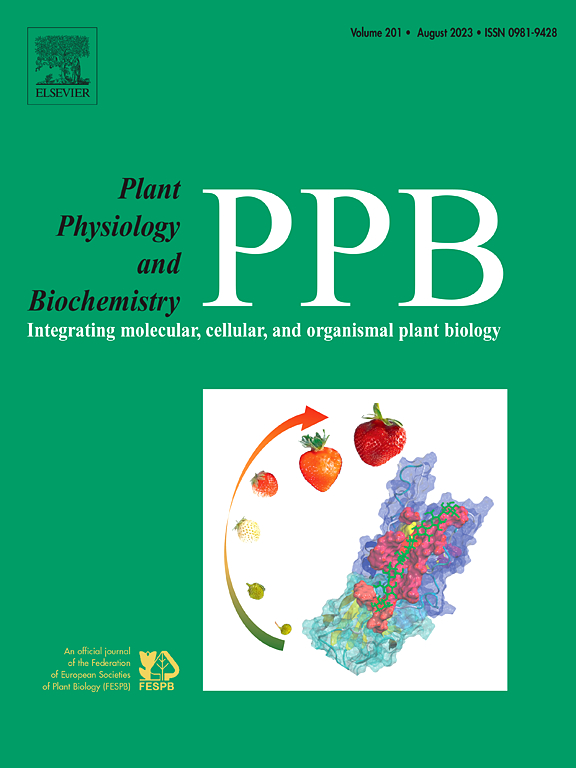Nitrogen demand disparities and physiological responses in grapevine cultivars under contrasting nitrogen regimes
IF 6.1
2区 生物学
Q1 PLANT SCIENCES
引用次数: 0
Abstract
Nitrogen assimilation critically regulates plant developmental plasticity and metabolic homeostasis. Although intraspecific nitrogen demand variation influences agricultural efficiency, its systematic characterization in grapevines remains limited. This study elucidated cultivar-specific nitrogen responsiveness through Comparative growth-physiological analysis of two phenotypically distinct Vitis vinifera cultivars (‘Red Globe’ and ‘Crimson Seedless') under five controlled nitrogen regimes (3.34, 6.68, 13.36, 20.04, and 26.72 mM). The findings indicated that nitrogen levels play a crucial role in regulating the growth and physiological processes of two grapevine cultivars. The ‘Red Globe’ demonstrated optimal growth at a nitrogen concentration of 20.04 mM, while the ‘Crimson Seedless' reached its peak performance at 13.36 mM, reflecting a 33.3 % lower nitrogen requirement compared to ‘Red Globe’. Both cultivars experienced growth inhibition and impaired physiological traits under conditions of both nitrogen deficiency and excess. At their respective optimal nitrogen concentrations, both cultivars accumulated significant biomass in aboveground tissues and roots, maintained elevated chlorophyll levels in leaves to maximize photosynthetic capacity, and enhanced protective enzyme activities (e.g. SOD, POD, CAT), along with osmolyte accumulation. These adaptations strengthened antioxidant defenses and sustained physiological functionality. Gene expression analysis revealed that key nitrogen metabolism genes in ‘Crimson Seedless' (VvNR1/2, VvGDH, VvNiR) were upregulated with increasing nitrogen supply but were rapidly downregulated under conditions of nitrogen excess, indicating more rapid adaptive metabolic responses. Comparative analysis revealed that ‘Crimson Seedless' exhibited heightened sensitivity to nitrogen, whereas ‘Red Globe’ showed greater tolerance to nitrogen variations. These findings offer significant insights for the precision management of nitrogen in grape cultivation.
不同施氮条件下葡萄品种氮素需求差异及生理反应
氮同化对植物的发育可塑性和代谢稳态起着至关重要的调节作用。尽管种内氮需求变化影响农业效率,但其在葡萄中的系统表征仍然有限。本研究通过对比生长生理分析,在5种不同氮肥水平(3.34、6.68、13.36、20.04和26.72 mM)下,对两个表型不同的葡萄品种(“红地球”和“深红无籽”)的氮肥响应性进行了研究。研究结果表明,氮素水平对两种葡萄品种的生长和生理过程起着至关重要的调节作用。“红地球”在氮浓度为20.04 mM时表现出最佳生长,而“深红无籽”在13.36 mM时达到峰值,反映出与“红地球”相比,氮需求量降低了33.3%。两个品种在缺氮和过量条件下均出现生长抑制和生理性状受损。在各自的最佳氮浓度下,两个品种在地上组织和根部积累了显著的生物量,叶片叶绿素水平保持较高,以最大限度地提高光合能力,保护酶活性(如SOD、POD、CAT)增强,并增加渗透物积累。这些适应增强了抗氧化防御和维持生理功能。基因表达分析表明,‘赤红无籽’的关键氮代谢基因(VvNR1/2、VvGDH、VvNiR)随氮供应增加而上调,但在氮过量条件下迅速下调,表明适应性代谢反应更为迅速。对比分析显示,“深红无籽”对氮表现出更高的敏感性,而“红地球”对氮的变化表现出更强的耐受性。这些发现为葡萄种植中氮的精确管理提供了重要的见解。
本文章由计算机程序翻译,如有差异,请以英文原文为准。
求助全文
约1分钟内获得全文
求助全文
来源期刊
CiteScore
11.10
自引率
3.10%
发文量
410
审稿时长
33 days
期刊介绍:
Plant Physiology and Biochemistry publishes original theoretical, experimental and technical contributions in the various fields of plant physiology (biochemistry, physiology, structure, genetics, plant-microbe interactions, etc.) at diverse levels of integration (molecular, subcellular, cellular, organ, whole plant, environmental). Opinions expressed in the journal are the sole responsibility of the authors and publication does not imply the editors'' agreement.
Manuscripts describing molecular-genetic and/or gene expression data that are not integrated with biochemical analysis and/or actual measurements of plant physiological processes are not suitable for PPB. Also "Omics" studies (transcriptomics, proteomics, metabolomics, etc.) reporting descriptive analysis without an element of functional validation assays, will not be considered. Similarly, applied agronomic or phytochemical studies that generate no new, fundamental insights in plant physiological and/or biochemical processes are not suitable for publication in PPB.
Plant Physiology and Biochemistry publishes several types of articles: Reviews, Papers and Short Papers. Articles for Reviews are either invited by the editor or proposed by the authors for the editor''s prior agreement. Reviews should not exceed 40 typewritten pages and Short Papers no more than approximately 8 typewritten pages. The fundamental character of Plant Physiology and Biochemistry remains that of a journal for original results.

 求助内容:
求助内容: 应助结果提醒方式:
应助结果提醒方式:


